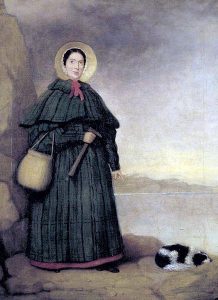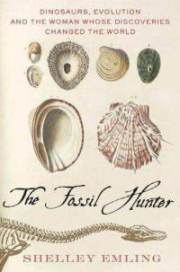 Few kids know what they want to do with their lives by the time they are ten or twelve, but twelve-year-old British fossil collector and paleontologist Mary Anning already knew. She was the child of a poor family, and she made her first archeological discovery the year she turned twelve. Anning searched for fossils in the area’s Blue Lias cliffs, particularly during the winter months when landslides exposed new fossils that had to be collected quickly before they were lost to the sea. One day, while fossil-hunting on the cliffs of Lyme Regis, England, Anning found what was believed to be the first dinosaur skeleton…an ichthyosaur, a prehistoric reptile.
Few kids know what they want to do with their lives by the time they are ten or twelve, but twelve-year-old British fossil collector and paleontologist Mary Anning already knew. She was the child of a poor family, and she made her first archeological discovery the year she turned twelve. Anning searched for fossils in the area’s Blue Lias cliffs, particularly during the winter months when landslides exposed new fossils that had to be collected quickly before they were lost to the sea. One day, while fossil-hunting on the cliffs of Lyme Regis, England, Anning found what was believed to be the first dinosaur skeleton…an ichthyosaur, a prehistoric reptile.
Prior to Anning’s discovery, people didn’t believe that anima extinction was a real thing. Anning was up against some big obstacles in the field of science, because of her gender, so it was amazing that her findings were given any credence at all. In addition, her social class…a big thing in those days, also made it difficult for her to fully participate in the scientific community of 19th-century Britain. Nevertheless, she read as much scientific literature as she could get her hands on and went on to become a renowned fossil-hunter and dealer, often risking her life in the face of landslides and daunting cliffs. She was not going to let her gender or social class stop her from using her mind to its fullest capacity. She wanted to learn more and discover more, and she was determined to do so. Anning did get some of the recognition she deserved when the great Stephen Jay Gould, who was the most beloved popular science writer of all time, called her “probably the most important unsung (or inadequately sung) collecting force in the history of paleontology.” To say the least, her work started a fundamental shift in scientific thinking about prehistoric life in the early 19th century.
Mary Anning was born on May 21, 1799. She struggled financially for much of her life. Her family was poor. Her father, a cabinetmaker, died when she was eleven. Anning, herself, nearly died in 1833 during a landslide that killed her dog, Tray. Working in landslide conditions was dangerous, but it was often her only chance to make her discoveries. Nevertheless, this English fossil collector, dealer, and paleontologist, went on to become known around the world for important finds she made in Jurassic marine fossil beds in the cliffs along the English Channel. In addition to the ichthyosaur, she found the first two more complete plesiosaur skeletons, the first pterosaur skeleton located outside Germany, and important fish fossils. Her observations also played a key role in the discovery that “coprolites, known as bezoar stones at the time, were fossilized feces. She also discovered that belemnite fossils contained fossilized ink sacs like those of modern cephalopods.” When geologist Henry De la Beche painted Duria Antiquior, the first widely circulated pictorial representation of a scene from prehistoric life derived from fossil reconstructions, he based it largely on fossils Anning had found, and sold prints of it for her benefit. A wonderful act of kindness.
Anning was not able to fully participate in the scientific community of 19th-century Britain, who were mostly Anglican gentlemen. Nevertheless, she became well known in geological circles in Britain, Europe, and America, and was consulted on issues of anatomy, as well as about collecting fossils. Still, as a woman, she was not eligible to join the Geological Society of London and she did not always receive full credit for her scientific  contributions…and incredible injustice. As a result, she wrote in a letter, “The world has used me so unkindly, I fear it has made me suspicious of everyone.” There was only one scientific writing of hers that was published in her lifetime. It appeared in the Magazine of Natural History in 1839. It was simply an extract from a letter that Anning had written to the magazine’s editor questioning one of its claims. It seems surprising to me that they printed that at all.
contributions…and incredible injustice. As a result, she wrote in a letter, “The world has used me so unkindly, I fear it has made me suspicious of everyone.” There was only one scientific writing of hers that was published in her lifetime. It appeared in the Magazine of Natural History in 1839. It was simply an extract from a letter that Anning had written to the magazine’s editor questioning one of its claims. It seems surprising to me that they printed that at all.
After her death on March 9, 1847, her unusual life story finally began to gain the interest it deserved. An uncredited author in All the Year Round, edited by Charles Dickens, wrote of her in 1865 that “[t]he carpenter’s daughter has won a name for herself, and has deserved to win it.” It has often been claimed that her story was the inspiration for the 1908 tongue-twister “She sells seashells on the seashore” by Terry Sullivan, but that has not been confirmed. In 2010, a full 163 years after her death, the Royal Society finally included Anning in a list of the ten British women who have most influenced the history of science. Rather late in all reality.


Leave a Reply